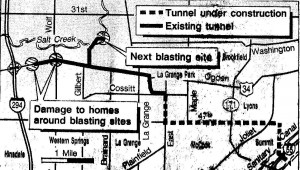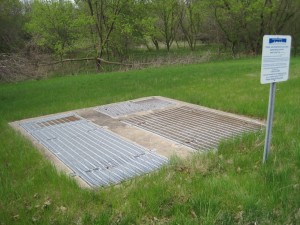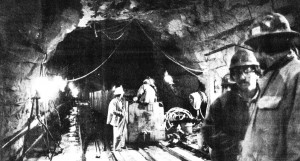Just north of Ogden Avenue, 150 feet below the ground, the Deep Tunnel runs from Forest Avenue in Western Springs to LaGrange Road. But, its construction wasn’t easy for the workers or for some residents.

Typical section of the Deep Tunnel
More than 35 years ago, the Metropolitan Water Reclamation District of Greater Chicago embarked on a massive, $2.4 billion engineering project aimed at capturing stormwater and sewage, thereby also reducing the harmful effects of flushing raw sewage into Lake Michigan. This involved boring underground tunnels, ranging from 10 to 33 feet in diameter.
During heavy storms, the tunnels were designed to hold up to 2.3 billion gallons of water and sewage. Afterward, the contents would be pumped out, treated at the huge Stickney water treatment facility, and released into the Sanitary and Ship Canal.

Deep Tunnel in the west suburbs
Tunnel construction was a slow laborious process, the majority of which was underwritten by federal funds. In 1983, then-Senator Chuck Percy announced his support of a $42 million appropriation to build the 3.5 mile stretch along Ogden Avenue. This would help curb flooding and pollution in Western Springs, LaGrange, and LaGrange Park.
What could possibly go wrong? Well, dynamiting for one thing. In order to begin the tunnel boring process, 150-foot-deep vertical drop shafts had to be constructed into which the machinery and other construction materials could be lowered. The shafts were also used to remove the limestone from the boring process.
That meant using dynamite to break through the layers of rock. But, soon, 60 homeowners from all three communities were reporting broken windows, cracked plaster, damaged floors, and foundation cracks. And, these residents were demanding answers in public meetings.

Drop shaft just north of Ogden & Grove – 2013
While many promises were forthcoming from the sanitary district and its contractor, all homeowner claims were summarily denied by the insurance companies. Months and years of finger-pointing ensued. However, because of the growing number and intensity of the complaints, as well as the refusal of some villages to allow further blasting, the sanitary district and its contractor finally agreed to cease using dynamite in favor of more expensive drilling. And, after ten years, the sanitary district also agreed to an arbitration plan whereby some relief would be available to homeowners with damage.
Constructing the tunnels was a 24-hour operation with three shifts. It was also dirty and dangerous work. Unfortunately, the project was not without accidents. In 1985, a worker was killed at Ogden & Brainard when he was overcome by poisonous gas in a drop shaft and fell to his death. Then, in 1986, a worker was killed at Ogden & Grove when a section of pipe fell into the drop shaft, striking him. And, the accidents didn’t stop there. In 1988, as workers were connecting a Western Springs sewer to the Deep Tunnel near Wolf Road, the dirt walls on the construction site collapsed, killing one and injuring another.

Workers near the LaGrange end of the tunnel
When the Ogden Avenue tunnel was completed, the Village of Western Springs had to subsequently invest nearly $3 million in its own sewer system to take full advantage of the new system. However, good things did result from the project. A connection at 39th & Hampton helped alleviate flooding problems that had plagued that corner of the village for 30 years. And, other connections at both Wolf Road and at Howard Avenue greatly alleviated flooding problems for other portions of the village in subsequent years.
